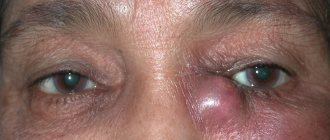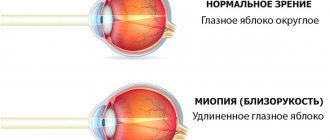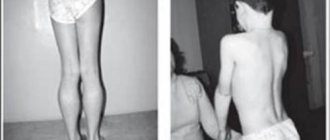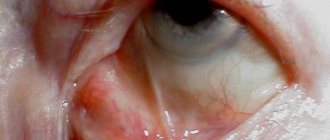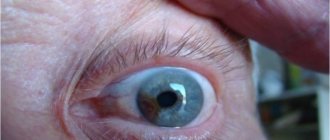If a person begins to have difficulty distinguishing objects located in the distance, and his vision is steadily declining, then doctors talk about progressive myopia. Under the influence of external and internal factors, the degree of myopia may increase. In this case, a diagnosis is carried out to determine whether the myopia is true or false, and then a number of therapeutic and preventive measures are prescribed to stop the decline in visual acuity.
What is progressive myopia
A diagnosis of progressive myopia is usually made if vision decreases by 1 or more diopters per year. Progressive myopia or myopia is a condition that causes understandable anxiety in the patient. When vision becomes worse, a person begins to fear that he will not be able to restore it to its original sharpness or may even lose it completely. How justified such fears are depends on the type of myopia:
- Benign myopia. Most often it begins to develop in childhood or adolescence, during schooling. The eyeball continues to grow until adulthood, and along with it, vision gradually deteriorates. Usually the development of myopia stops along with the cessation of eye growth by 20-22 years.
- Malignant myopia. Contrary to the name, this type of myopia is not associated with cancer. This is the name for a type of myopia in which vision continues to decline into adulthood, after 20 years. In some cases, the final figures can reach -20 and even -30 diopters. This is usually due to environmental factors that can be influenced, but variations are possible.
Also, myopia can be not only true, but also false. False pathology with spasm of accommodation - a condition that is caused by spasm of the eye muscles from overexertion. In this case, the task is simplified: with the removal of the spasm of accommodation, vision is restored. Depending on the type of myopia, treatment tactics vary.
Classification of myopia
The development of myopia usually occurs in childhood. It especially often manifests itself at the beginning of school, when the load on the visual organs increases many times over. If a child also has a predisposition to myopia (hereditary factor), then its occurrence is almost inevitable.
The main causes of myopia are the physiological structure of the visual organs. With this pathology, light rays are focused in front of the retina without hitting it, causing distant objects to be seen blurry. Very often the development of myopia is influenced by the size of the eyeball. It extends in length along the anteroposterior axis more than normal and continues to grow. An increase in the eyeball by just 1 mm leads to a change in refraction by 3 diopters. This type is called axial myopia.
When the cornea or lens thickens, light rays are refracted too strongly, as a result of which they also do not reach the retina. At the same time, the size of the eyeball remains normal and does not increase. This type of myopia is called refractive myopia. The cause of the appearance may be diabetes mellitus, sclerosis, in which the lens thickens, as well as other pathologies of this natural lens or cornea.
Classification by degree
As the disease develops, it passes from one degree to another, in severe cases reaching 30 units. In order to track the rate of development of myopia and indicate its severity, pathology is classified by degree.
There are three types:
- Progressive mild myopia: up to - 3 diopters.
- Progressive moderate myopia: more than 3 but less than 6 diopters.
- Progressive high myopia: over 6 diopters.
If the change in refraction is less than 0.5 diopters per year, myopia is called stable, about 1 diopter - progressive, and if by more than 1 diopter per year - rapidly progressing.
Prevention of myopia
Prevention consists of applying a few simple rules and using special exercises. If you already have mild myopia in both eyes, these measures will help prevent its further development and improve your vision.
Previously, it was believed that the key to the problem lay in the sclera. Today it is believed that it is related to the retina, since the retina develops significantly in postnatal life, almost doubling its area, and it makes sense that the axial length of the eye fits into this tissue. Therefore, when the retina grows faster and more extensively than normal, the sclera becomes stretched and myopia occurs.
However, there are also factors that have a certain influence on their progression.
Such would be a case of the importance of working closely in etiology. Overall, it would appear that the influence of near visual work is secondary to the etiology of the process, which is essentially predetermined and constitutional rather than ecological
The latter will only be able to influence when it is associated with poor eye hygiene and the lack of adequate means for normal and healthy visual development.
Prevention of the diagnosis of low myopia consists of:
- in maintaining visual hygiene: it is necessary to have a well-lit workplace, do not read at close range, spend moderate time watching TV and monitors;
- in a balanced diet: it is recommended to consume foods containing vitamins for the eyes;
- in the use of well-chosen optics;
- regularly performing eye exercises;
- in alternating work and rest regimes.
In addition, from an early age it is necessary to teach the child to keep all objects in question at a distance of 30 cm: drawings, books, pictures, etc. This not only helps prevent eye pathology, but also prevents the development of spinal diseases. Myopia occurs primarily from eye fatigue.
There are very rare cases of myopic newborns, although in some cases myopia is congenital, and in some of these cases the process remains static. A common process in childhood is a change in refraction in the form of farsightedness, which will decrease over time, and in some cases it will end in simple myopia. This change will not cause symptoms of vision error until adolescence, although some people may experience it early. From this point on, these cases will typically progress in subsequent years to 5 or 6 diopters, and finally stabilize around age 21 or earlier in women.
There are several easy exercises to relieve fatigue. Gymnastics helps normalize metabolism in the eye muscle, improve its tone, and increases blood circulation in the retina of the organs of vision.
OI myopia can be prevented by using the following exercises:
- Sitting on a chair, tilt your head back and close your eyelids as much as possible for 5 seconds, then widen them, holding for 10 seconds. Repeat 3-4 times.
- Without raising your head, make rotational movements with your pupils clockwise and counterclockwise, repeat 2-3 times;
- Standing on straight legs, stretch your arms forward, focus your gaze on your index finger and slowly bend and straighten your elbow, bringing your finger to the tip of your nose. Repeat 3-5 times.
- Approaching the window, you need to select an object on the horizon and peer into it for 3-5 seconds, then turn your eyes to the window. Repeat 3-5 times.
Modern life is impossible without TV and computer. At the same time, the strain on the eyes has increased significantly. This explains the frequent diagnosis of myopia in children and adults. The main reason for the development of the disease is weakness of the sclera and the muscle responsible for accommodation - the ability of the eye to accurately distinguish objects located at different distances.
Causes of the disease
The development of progressive myopia can be caused by both internal causes and external influences, sometimes in combination.
- Genetic reasons. It has been proven that progressive myopia can be caused by genes - weak, stretchable sclera can be inherited and increase the tendency for a child to develop progressive myopia.
- Visual strain. Excessive strain on the eyes - constant work with small objects at close distances, long hours of work in front of a computer monitor, etc. This can cause not only a spasm of accommodation, but also the development of true myopia.
- Lifestyle. Pollution in large cities, lack of fresh air, insufficiently healthy diet, physical inactivity, lack of proper sleep and wakefulness also contribute to the development of progressive myopia.
- General weakening of the body: frequent infectious diseases, many chronic diseases also contribute to the occurrence of corresponding eye pathology.
- Hormonal changes: pregnancy, childbirth, menopause can also contribute to the appearance of progressive myopia.
The above reasons can be combined with each other, leading to decreased vision.
Methods for improving vision for myopia
Treatment of the disease is primarily aimed at reducing the refractive power of the light beam and focusing it in the central part of the retina. To correct vision for myopia, an integrated approach is used, which includes:
- drug therapy;
- wearing glasses or contact lenses to weaken the optical ability of the eyes and shift the focus from distant objects to the retina;
- taking vitamins;
- surgical and hardware techniques.
First of all, patients are recommended to normalize the intake of vitamins and microelements in the body. For myopia, vitamins B1, B2, B3, B6, B12, C are especially necessary, as well as microelements - manganese, zinc, copper, magnesium
It is important to eat foods that contain high levels of these substances. Patients are also often prescribed multivitamin complexes.
Drug therapy involves taking the following drugs:
- hypotensive - Labetalol, Timolol, Pilocarpine;
- affecting accommodation - Pirenzepine, Atropine, Cyclopentolate.
The most effective ways to treat myopia are modern surgical and hardware methods. Most often, patients with this diagnosis are prescribed the following methods of vision correction:
- Laser exposure. This is one of the most reliable and effective methods. It allows you to cope even with severe myopia and relieve the patient from wearing glasses or contacts. Involves a change in the shape of the cornea.
- Installation of phakic lenses. This method involves implanting an optical product into the anterior or posterior chamber of the eye through a micro-tissue incision. Allows you to normalize vision in severe myopia and preserve natural accommodation.
- Refractive therapy. Suitable for vision correction in children and young people. This is a non-surgical technique that involves the use of lenses for night wear to correct the shape of the cornea in the early stages of myopia development.
- Lansectomy. A surgical treatment method during which the lens is removed and replaced with an artificial analogue. This operation is used when laser correction is ineffective, as well as when the lens loses its ability to accommodate.
- Scleroplasty. A surgical correction method that is used for progressive myopia. Its task is to prevent the enlargement of the eyeball and slow down the decline in visual acuity. Scleroplasty involves installing a plate that creates a frame for the sclera and strengthens the walls of the eye.
Special visual training is often used in combination with basic treatment methods. They help muscles relax, reduce tension, improve color perception and help regulate the regulation of the accommodation process.
Symptoms of the disease
The main symptom of progressive myopia is obvious: the patient has poor distance vision. However, there are signs by which a progressive type can be recognized:
- vision is constantly deteriorating, not stabilizing at one refraction value;
- the patient has a wide palpebral fissure;
- the field of view narrows;
- conjunctivitis becomes more frequent;
- there is a habit of squinting in an attempt to see distant objects.
The listed signs indicate that myopia has appeared and is progressing.
How to treat moderate myopia?
Treatment of the disease is carried out in several directions:
- Selection of corrective optics;
- Prescribing medications, vitamin complexes;
- Surgical intervention.
Glasses and contact lenses do not eliminate the disease, but allow the patient to return to a full life and clearly see objects located at a distance. If you want to restore your vision to 100%, then you cannot do without surgery. The LASIK technique is in greatest demand.
Vision correction
Only an ophthalmologist should select and prescribe corrective optics. Therefore, when the first symptoms of an anomaly appear, immediately go to the clinic, and not to the pharmacy. Before writing a prescription for glasses or lenses, the doctor will conduct a series of examinations, after which he will draw up the optimal therapeutic course and select optics based on the individual characteristics of your organ of vision.
To correct myopia, diverging (minus) eyepieces are used. They shift the focus so that it falls directly on the retina. Glasses do not need to be worn all the time; they are worn as needed. For example, when driving a car. However, if deviations in refraction exceed the mark of five diopters, then optics will have to be used constantly.
Drug therapy
Treatment of moderate myopia is impossible without taking medications. The doctor selects complex therapy, which includes the use of eye drops and vitamin courses. The main purpose of medications is to relax the muscles of the organ of vision and strengthen the walls of blood vessels. The drugs also normalize blood circulation and improve the condition of the retina.
The most popular product is a vitamin complex, which includes retinol, thiamine, and riboflavin. Additionally, the doctor may prescribe sodium gluconate, which helps strengthen the vascular system and prevents hemarthrosis in the retina.
| To eliminate false myopia, the drug “Oko-plus” or “Tropicamide” is used. However, they must be used very carefully, since medications can cause an increase in intraocular pressure. |
Surgical treatment
To block the development of the disease, scleroplasty is performed. The procedure helps strengthen the sclera and prevent further increase in the length of the eyeball. However, existing deviations in refraction remain. Laser correction or keratoplasty will help improve visual acuity. For stationary myopia, refractive surgery is recommended.
Laser vision correction
It is considered the most effective way to get rid of myopia. The laser reduces the degree of curvature of the central part of the cornea, thereby normalizing focusing and restoring visual acuity. This type of correction is used not only for mild and moderate myopia, it can even cope with severe refractive errors (up to fifteen diopters).
Before the intervention, the patient is carefully examined and diagnostic measures are carried out to analyze the condition of the eyeball, cornea and lens. The obtained data is entered into a computer program, which automatically calculates the power of the laser installation.
The entire operating process is also controlled by a computer, so the risk of error is reduced to zero. Laser correction takes only a few minutes, and after the procedure the patient goes home almost immediately. Vision is restored within ten days.
Exercises
Gymnastics helps normalize blood circulation in the eye muscles, increase its tone and eliminate spasms of the extraocular muscles. Simple exercises stop the deformation of the eye and help partially restore visual acuity. For gymnastics to bring results, it must be performed regularly.
The set of techniques includes squinting, circular movements of the eyes, focusing the gaze alternately on near and distant objects, etc. Some patients try to get rid of the disease using traditional recipes. Many of them include blueberries, walnuts, and carrots among the ingredients. For example, blueberry juice diluted with water in a ratio of 1:2 is recommended to be dropped into the eyes after waking up.
Watch a useful video about treating myopia.
How to stop progressive myopia
First of all, treatment of progressive myopia is aimed at slowing down, and ideally stopping, the decline in vision. For this purpose, therapeutic and preventive measures are prescribed, the complex effects of which should lead to the expected positive result. In order for the patient to be able to stop the progression of myopia, he must strictly follow all the recommendations of the attending physician.
Glasses and lenses
First of all, a patient with progressive myopia is prescribed adequate optical correction, which is designed to reduce eye strain and restore the patient’s quality of life.
Success largely depends on the correct selection of glasses or contact lenses, so independent purchase of ready-made glasses by fitting is strictly unacceptable. This can only accelerate the development of myopia.
Properly selected glasses that take into account all refractive parameters and the distance between the pupils will not only provide sharp vision, but will also help stop the progression of myopia. The doctor checks your vision using a refractometer and then selects the right lenses using a visual acuity chart.
Surgical treatment
Laser correction is most often contraindicated until vision has stabilized, so if surgical intervention is necessary, classical surgery is performed.
In childhood, scleroplasty is used for the surgical treatment of progressive myopia. It does not eliminate myopia, but it stops its progression by strengthening the sclera.
Indications for such an operation are:
- lack of effect from conservative treatment;
- complications of severe myopia in the form of degenerative changes in the retina, its detachment or rupture;
- malignant rapidly progressing myopia with a drop in vision to -20-30 units.
Scleroplasty, if indicated, can be performed in children and adults.
Other types of operations for progressive myopia are:
- Keratotomy is excision of the cornea with a scalpel to change its refractive properties.
- Replacement of the eye lens is carried out in cases with a high degree of progressive myopia. The diseased lens is removed, and an artificial intraocular lens is placed inside the eye.
- Placement of an intraocular lens without extraction of the natural lens.
Surgical treatment is prescribed by a doctor after a thorough diagnosis and collection of the patient’s medical history. In most cases, progressive myopia can be stabilized with surgery.
Exercises to improve vision
Eye gymnastics plays an important role in the treatment of progressive myopia. Special exercises have a beneficial effect on the blood supply to the organ of vision, help relieve spasm of accommodation and prevent its development, and strengthen the muscles of the eye.
In this video you can learn about eye exercises that are useful both for myopia and for the prevention of eye diseases.
Correction of progressive myopia using optics and medications
How is this visual ailment treated? Too high degrees of myopia are not easily corrected with glasses or contact lenses. Especially childhood myopia tends to progress rapidly, so correction must begin as soon as possible.
Glasses or contact lenses will not stop the progression of the disease, but they will help relieve the strain on the eyes when looking at distant objects, and this will help reduce the rate of loss of vision. Glasses in this case act as a therapeutic agent.
Myopia is dangerous due to its complications. Hemorrhage due to increased intraocular pressure may occur, and the retina may rupture or detach, leading to blindness. From the age of 10 you can use soft or hard contact lenses.
In addition to optical correction, the patient is also prescribed medications that relax the ciliary body. Regular exercises to strengthen the eye muscles will help prevent the growth of the eyeball along the anteroposterior axis in axial myopia. You also need to additionally take vitamin supplements and foods containing phosphorus, magnesium, zinc, and potassium.
Features of progressive myopia in children
Most often, the disease occurs in children between 6 and 18 years of age. During schooling, the load on growing eyes increases many times over, which provokes a rapid decline in vision in the event of myopia development. After the diagnosis is made, the child is prescribed:
- adequate optical correction (glasses),
- gymnastics to strengthen the eyes and relieve spasm of accommodation,
- dosing of visual load,
- proper diet and sleep.
If the measures taken do not help and vision quickly declines, scleroplasty surgery is prescribed to stop the progression of the disease. All school students are recommended to visit an ophthalmologist at least twice a year for timely detection and correction of progressive myopia.
Surgical methods of treatment for progression of myopia
Leaving this pathology without the attention of specialists is unacceptable and dangerous. As it develops, the central parts of the retina gradually change, which can lead to blindness. What does modern ophthalmology offer to save a person from this disease and preserve vision? The most reliable and effective way to stop axial myopia is called scleroplasty. It is important that it can be performed even in childhood, starting from the age of eight, while laser correction is carried out only from the age of 18. Scleroplasty surgery is aimed at strengthening the sclera, the lining of the eyeball, to avoid further stretching with progressive myopia. It can be simplified, simple and complex.
In simplified scleroplasty, a polymer material or a natural biological liquid substance is used, which is injected into the eyeball through a micro-incision using a syringe. After some time, the material hardens and prevents further growth of the eye. For simple and complex scleroplasty, the technology involves the use of special reinforcing plates: they are placed behind the eye and attached to it, then fused with the sclera and prevent the eyeball from stretching.
After the procedure, the number of vessels supplying the posterior pole of the eye increases, so its blood supply also improves. The operation takes only 15-20 minutes, and you can leave the clinic in the evening.
In case of peripheral retinal dystrophy, which can cause detachment or rupture, laser coagulation surgery is performed using local anesthesia. The high-temperature laser beam seems to “weld” the damaged areas of the retina to the choroid, tightly connecting them. Laser photocoagulation is prescribed to pregnant women with moderate and high degrees of myopia to eliminate the risk of retinal rupture at the time of childbirth.
Lensectomy may also be prescribed - refractive replacement of the natural lens in case of pathology with an artificial intraocular lens, penetrating keratoplasty - corneal transplantation, radial keratotomy, laser keratomileusis. The method of surgical intervention to stop progressive myopia is prescribed depending on the patient’s age, the individual parameters of his eyes, as well as the type of myopia (axial, refractive).
How to prevent disease
Prevention of progressive myopia includes a set of measures designed to reduce eye strain and improve the health of the visual system as a whole. For this it is recommended:
- Properly organize the workplace of a child or adult: provide good lighting, anatomically correct furniture.
- Observe the correct mode of working with the computer. The eyes should be at least 40 cm, and for children - 50 cm from the monitor. Continuous work time should be limited to 45 minutes, after which a 15-minute break is taken.
- Perform strengthening exercises for the eyes regularly.
- Monitor your sleep and wakefulness patterns, eat right, and walk more in the fresh air.
Progressive myopia is a serious disorder that requires careful attention and immediate consultation with a doctor when signs of the disease appear. If you seek medical help in a timely manner and follow the recommendations, the decline in vision can be slowed down and even stopped. How to quickly remove dark circles under the eyes, you will find the answer in the link.
Prevention of myopia progression
For myopic people, it is very important to follow the rules that will help avoid the appearance of provoking factors that contribute to vision deterioration. These rules are especially important for those who have hereditary myopia, which, if negatively influenced, can begin to develop sharply. It is very important from childhood to teach a child to read and write at the correct distance, which should be at least 30 centimeters from the face. You also need to ensure good lighting and correct posture. Habits developed in childhood will then help maintain quality vision into adulthood.
Myopic people should choose the right sports: disciplines that may involve blows to the head, sudden jumps or turns are contraindicated for them: boxing, basketball, strength sports. But skiing, swimming, skating, and active walks in the fresh air can be a good tonic for eye health. To prevent the progression of myopia, you need to choose the right means of correction - glasses or contact lenses, and also follow the prescribed wearing regimen. With high visual loads, you need to rest your eyes: for patients with weak or moderate degrees of myopia every 15 minutes, and for high degrees - at intervals of 10 minutes.
Visual acuity should be checked at least every six months to check for changes if they occur. You may need to buy stronger glasses or contact correction devices. Myopic people should also be attentive to their diet, include foods that are healthy for their eyes, and take a course of vitamin supplements several times a year. Special gymnastics for the ciliary muscle for axial myopia, which must be done regularly for it to have the desired effect, helps to strengthen the muscles. You can also periodically undergo hardware treatment: for example, laser therapy sessions using an infrared laser, which promote good microcirculation in the eye tissues, relieve muscle tension, and stimulate the functioning of the retinal nerve cells. Magnetic therapy, electrical stimulation, vacuum massage and other types of influence are also used.
The reasons for the development of progressive myopia can be different, and patients with myopia should remember to take care of the health of their eyes. We talked about what preventive measures myopic people should take to avoid the onset of progression of the disease. If symptoms of visual impairment appear, you should immediately contact an ophthalmologist for diagnosis. Timely detection of pathology will help prevent its sudden development and select the appropriate treatment method.
Prevention
Prevention of myopia should be carried out at any age. A number of measures are being taken to prevent progressive myopia:
- to avoid the development of myopia in young children, you should pay attention to the purchase of children's books - the pictures and letters in them should be clear so that the child does not experience excessive eye strain;
- it is necessary to ensure good lighting in the apartment or workplace;
- It is recommended to limit watching TV and computer use to the minimum possible;
- should be read only in good lighting, do not read while traveling in public transport;
- You should also pay attention to nutrition - a set of vitamins (A, C, carotene and calcium contained in dairy products) is simply necessary for the eyes.
Useful video
Myopia - symptoms and prevention:
Causes
The disease is multifactorial. It often occurs in people whose parents also had myopia. The development of myopia is also facilitated by congenital features of the structure of the eyes - weakness of the muscles, sclera, thickening of the eye lens - the crystalline lens.
Predisposing factors for the development of progressive myopia:
- prolonged work at close range;
- long work at the computer;
- frequent visual fatigue due to improper organization of work;
- low illumination of the workplace;
- immune and hormonally caused pathologies;
- lack of vitamins and microelements;
- infectious diseases.

